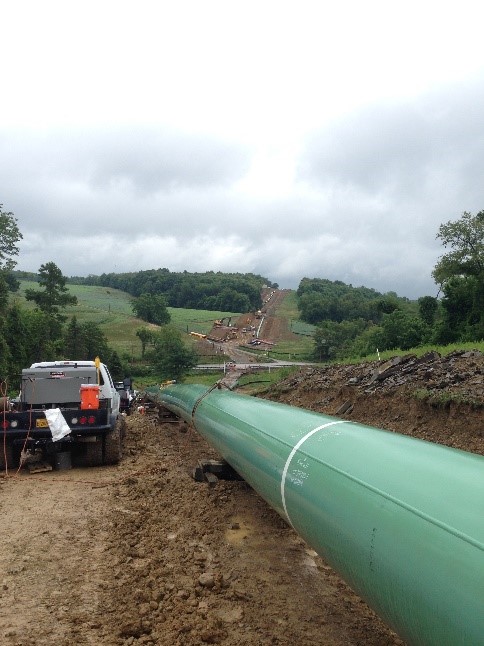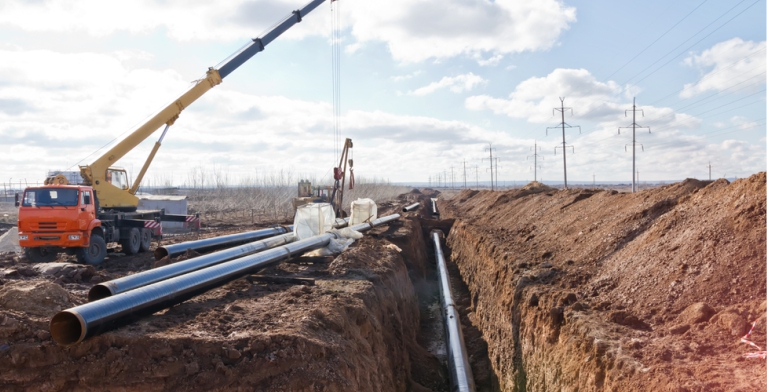Everything You Need to Know About Creek Pipe pipeline construction
Recognizing the Basics of Pipes Installation: What You Required to Learn About the Refine
Correct pipe installation is important for any type of plumbing system. It requires cautious consideration of different elements, including product selection and adherence to local regulations. A well-planned format can prevent issues like stress loss, while the right devices assure reliable signing up with strategies. Nonetheless, also experienced installers can make usual blunders. Understanding these essentials can result in an extra effective and durable system, prompting a closer consider the vital elements included in the process.
Selecting the Right Products for Pipe Installation
When taking into consideration pipe installation, the choice of proper materials is necessary to making sure sturdiness and functionality. Various products are offered, each offering distinct advantages and considerations. PVC pipelines are lightweight, immune to corrosion, and cost-efficient, making them excellent for residential pipes. Alternatively, copper pipelines, known for their long life and capability to withstand high temperature levels, are frequently liked for heating systems.Additionally, galvanized steel pipelines offer toughness and resilience, ideal for heavy-duty applications, although they are prone to rust over time.For underground installations, polyethylene pipelines are preferred as a result of their flexibility and resistance to stress and anxiety breaking. Appropriate product selection relies on the specific demands of the job, including pressure ratings, temperature variants, and the chemical nature of the liquids being transported - Creek Pipe near me. Inevitably, informed selections concerning pipe products add substantially to the total success and long life of plumbing systems
Comprehending Local Building Regulations and Rules
Exactly how can recognizing local building regulations and laws influence pipe installation? Experience with these codes is important for making sure that pipe setups are risk-free, certified, and reliable. Neighborhood structure codes lay out details requirements concerning products, installation strategies, and safety and security procedures, which should be stuck to to avoid prospective legal issues and pricey fines.Failure to abide can cause assessments being stopped working, delays in project conclusion, and even mandated elimination of improperly installed pipes. Additionally, recognizing zoning regulations and regulations can influence the kind of products allowed, as well as the methods used for installation.Contractors and homeowners alike need to spend time in evaluating regional guidelines prior to starting any type of installation task. This aggressive technique not only advertises safety and security yet likewise boosts the general high quality and sturdiness of the plumbing system, eventually cultivating lasting performance and complete satisfaction.
Planning Your Pipe Design and Design
Proper preparation of pipe format and style is essential for attaining an effective plumbing system. This process starts with assessing the certain needs of the area, taking into account the place of components and home appliances. Exact dimensions guarantee that pipes are properly transmitted, lessening bends and turns that can cause pressure loss.Consideration of the circulation rates and the sorts of products used is critical, as various products have varying toughness and compatibility with pipes systems. Furthermore, the developer ought to represent future developments or adjustments to the layout, enabling versatility in situation of renovations.Efficient drain and air flow are likewise significant elements of the layout, as they avoid obstructions and guarantee proper waste removal. Cooperation with regional building codes ensures conformity and safety and security, which is critical in any pipes installation job.
Crucial Devices and Devices for Installation
Effective pipe installation pivots on having the right tools and devices available. Important tools include pipe cutters for clean cuts, wrenches for tightening installations, and pliers for clutching and transforming pipelines. In addition, a degree assurances pipelines are set up uniformly, while a measuring tape aids in accomplishing specific lengths.For certain products, a blowpipe may be needed for copper pipelines, while a PVC cutter is vital for plastic options. Security tools, such as gloves and safety glasses, safeguards installers from potential hazards during the process.A pipe bender can be particularly useful for developing smooth curves without endangering honesty, while a torque wrench assurances that connections are safeguarded to the maker's specifications.Having these devices conveniently available not just promotes a smoother installation process but additionally adds to the overall resilience and capability of the plumbing system. Appropriate tools is essential in accomplishing resilient results.
Strategies for Proper Pipe Joining and Sealing
Achieving a safe and leak-free connection in between pipelines needs mindful focus to signing up with and securing techniques. Numerous methods exist, each suited to different pipe products and applications (Creek Pipe Texas oilfield). Welding is often utilized for steel pipes, making sure durable connections with warmth combination. On the other hand, plastic pipes take advantage of solvent concrete or blend welding, producing strong, irreversible bonds.Threaded connections are typical in both metal and plastic piping, calling for accurate positioning and using appropriate sealers, such as Teflon tape or pipe dope, to prevent leaks. Compression fittings use an additional choice, where mechanical pressure protects the pipelines with each other, making them quickly disassembled for maintenance.Regardless of the technique selected, appropriate prep work is important. This consists of cleansing pipe finishes and guaranteeing they are devoid of debris. Applying these techniques vigilantly will enhance the durability and dependability of the pipe system, inevitably adding to its reliable efficiency
Usual Mistakes to Avoid During Installation
During pipe installation, staying clear of usual blunders is essential for guaranteeing a dependable and effective system. One regular mistake is stopping working to determine and reduce pipes accurately, which can cause incorrect fittings and leakages. Additionally, disregarding to examine the compatibility of products can lead to deterioration or various other damage over time. Improperly securing joints and connections can also develop weak factors in the system, triggering prospective failures.Another index typical mistake is neglecting the importance of incline and water drainage; pipelines need to be installed at the correct angle to facilitate correct flow. Insufficient support for pipelines can result in sagging and stress, influencing the stability of the system. Ultimately, ignoring local codes and laws can lead to pricey rework and security risks. By recognizing these pitfalls, installers can greatly improve the sturdiness and performance of pipe systems.
Upkeep Tips for Lasting Pipe Solutions
To guarantee the durability of pipe systems, normal inspections and cleaning are necessary techniques. These measures assist determine possible concerns before they escalate into significant troubles. Furthermore, utilizing correct insulation strategies can additionally safeguard pipelines from temperature level variations and ecological factors.
Routine Assessments and Cleansing
Normal examinations and cleaning are important for preserving the durability and effectiveness of pipe systems. Routinely examining pipes for signs of corrosion, leaks, or clogs can help identify possible concerns prior to they rise right into pricey repairs. Cleansing pipelines occasionally removes build-up that can restrict flow and promote wear and tear. It is a good idea to arrange evaluations a minimum of annually, yet more constant checks might be needed in high-usage environments. Utilizing professional solutions for detailed cleansing assurances that all debris is successfully gotten rid of. Furthermore, keeping records of evaluations and maintenance tasks aids in tracking the system's wellness in time - Creek Pipe pipeline construction. By prioritizing these methods, homeowner can boost the reliability and lifespan of their pipe systems
Appropriate Insulation Strategies
Reliable insulation methods play a necessary role in keeping the efficiency and durability of pipe systems. Correct insulation lessens heat loss in hot water pipelines and prevents cold in cold water pipelines, considerably minimizing energy prices and potential damage. Usual materials used for insulation include fiberglass, foam, and rubber, each offering differing levels of thermal resistance. It is crucial to assure that insulation is applied consistently, covering all subjected locations without gaps. In addition, protecting insulation with appropriate fasteners assists maintain its setting and effectiveness gradually. Normal evaluations must be carried out to determine deterioration, assuring prompt replacements. By applying these techniques, pipe systems can operate successfully and have an extensive service life, ultimately benefiting both the atmosphere and the index home owner.

Regularly Asked Inquiries
Just how Do I Determine the Appropriate Pipe Size for My Task?
Determining the appropriate pipe dimension includes assessing the project's circulation needs, stress specs, and the kind of liquid being delivered. Consulting layout requirements and carrying out computations guarantees ideal performance and efficiency in the installation procedure.
What Are the Environmental Impacts of Various Pipe Products?

Can I Mount Pipes Myself or Should I Work with a Professional?
The question of whether to mount pipelines independently or work with a professional often relies on the person's ability degree and job complexity. A specialist click here to read might assure conformity with policies and decrease possible long-lasting issues.

How Long Can I Expect My Pipe Installation to Last?
The long life of pipe installation differs significantly, usually lasting 20 to 100 years, depending upon materials, installation top quality, and maintenance. Routine evaluations and correct treatment can improve sturdiness and avoid early failings.

What Are the Indicators of a Failing Pipe System?
Indications of a stopping working pipe system consist of constant leaks, unusual water stress modifications, tarnished water, mold development, and relentless moisture. Property owners ought to monitor these indicators to stay clear of expensive damage and guarantee prompt repair services are made.